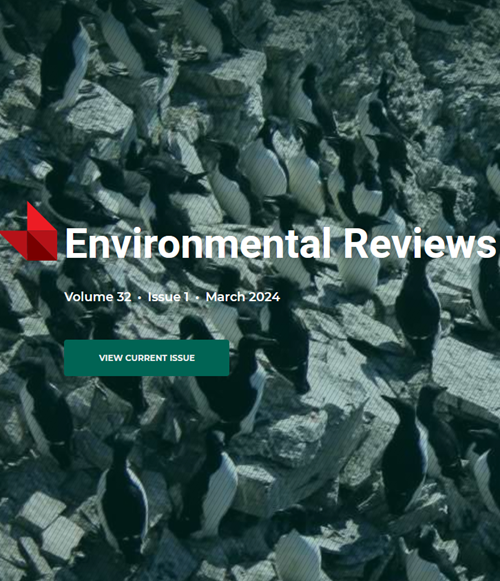Carbon sequestration in Canada’s croplands: A review of multiple disciplines influencing the science policy interface
IF 5.1
3区 环境科学与生态学
Q2 ENVIRONMENTAL SCIENCES
引用次数: 0
Abstract
One widely recognized climate change mitigation strategy in agriculture is enhancing soil carbon (C) sequestration – the process of capturing atmospheric carbon dioxide and storing it in the soil. By adopting natural climate solutions (NCS) such as cover crops, reduced tillage, and diverse crop rotations, farmers can increase soil C sequestration and co-benefits such as biodiversity. Canada is increasingly interested in better positioning farmers to adopt NCS via government cost-share programs, ecosystem marketplaces, and outreach and education initiatives. Given the policy and market driven interest in soil C sequestration in agriculture, there is a need to advance the science policy interface, ensuring foundational science, NCS implementation, and approaches to promote NCS are aligned. Herein, the objective is to present insights from multiple disciplines that can help build connections between soil carbon sequestration science and policy relevant to Canada's croplands. The method is a review of literature on soil and pedoclimate science, agricultural NCS adoption, agricultural NCS governance, and science policy interfaces to achieve this objective. From this review, key insights underline that Canadian cropland soils do not have a homogenous history in NCS adoption and production type, nor are all regions influenced by the same contextual factors, have the same potential in C storage or exist within the same agri-environmental conditions. Therefore, it is emphasized herein that policies that aim to enhance soil organic carbon in croplands should consider local context and C sequestration potential. Policies and programs implemented locally to enhance C sequestration across Canada should be complemented by nationally scalable measuring and monitoring to ensure outcomes are accounted for against climate goals. This review aims to contribute to building a common understanding of soil C sequestration in Canada’s croplands and its science policy interface. Efforts to further strengthen the science policy interface for soil C sequestration in Canada’s croplands might include greater integration and utilization of science and data from multiple disciplines, co-design and collaborative opportunities, and establishing on-the-ground test projects to explore innovation in policy and market design.加拿大农田的碳固存:影响科学政策界面的多学科综述
在农业领域,一个得到广泛认可的减缓气候变化战略是加强土壤碳(C)固存——捕获大气中的二氧化碳并将其储存在土壤中的过程。通过采用自然气候解决方案(NCS),如覆盖作物、减少耕作和多样化的作物轮作,农民可以增加土壤碳的固存和生物多样性等共同效益。加拿大越来越有兴趣通过政府成本分担计划、生态系统市场以及推广和教育举措,更好地定位农民,使其采用NCS。考虑到政策和市场对农业土壤碳封存的兴趣,有必要推进科学与政策的对接,确保基础科学、碳封存的实施和促进碳封存的方法保持一致。本文的目标是提出来自多个学科的见解,这些见解可以帮助在土壤碳封存科学和与加拿大农田相关的政策之间建立联系。该方法是对土壤和土壤科学、农业NCS采用、农业NCS治理以及实现这一目标的科学政策接口等方面的文献进行综述。从这篇综述中,关键的见解强调了加拿大农田土壤在NCS采用和生产类型方面没有同质的历史,也不是所有地区都受相同的背景因素影响,具有相同的C储存潜力或存在于相同的农业环境条件下。因此,本文强调,旨在提高农田土壤有机碳的政策应考虑当地环境和碳固存潜力。为加强加拿大各地碳封存而在当地实施的政策和计划,应辅以全国范围内可扩展的测量和监测,以确保结果符合气候目标。本综述旨在为建立对加拿大农田土壤碳封存及其科学政策界面的共同认识做出贡献。进一步加强加拿大农田土壤碳固存的科学政策接口的努力可能包括更多地整合和利用来自多学科的科学和数据,共同设计和协作机会,以及建立实地试验项目以探索政策和市场设计方面的创新。
本文章由计算机程序翻译,如有差异,请以英文原文为准。
求助全文
约1分钟内获得全文
求助全文
来源期刊

Environmental Reviews
环境科学-环境科学
自引率
3.50%
发文量
45
期刊介绍:
Published since 1993, Environmental Reviews is a quarterly journal that presents authoritative literature reviews on a wide range of environmental science and associated environmental studies topics, with emphasis on the effects on and response of both natural and manmade ecosystems to anthropogenic stress. The authorship and scope are international, with critical literature reviews submitted and invited on such topics as sustainability, water supply management, climate change, harvesting impacts, acid rain, pesticide use, lake acidification, air and marine pollution, oil and gas development, biological control, food chain biomagnification, rehabilitation of polluted aquatic systems, erosion, forestry, bio-indicators of environmental stress, conservation of biodiversity, and many other environmental issues.
 求助内容:
求助内容: 应助结果提醒方式:
应助结果提醒方式:


